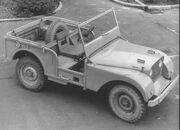
Land Rover Centre Steer
The Centre Steer is the name given by enthusiasts to the prototype of the Land Rover 4x4 vehicle built by the Rover Motor Company in 1946 in the United Kingdom. Being a prototype, only one example was built and the production vehicle differed significantly in many ways. The Land Rover was intended to be an agricultural vehicle based on the successful wartime Willys Jeep that could be exported to the Common Wealth countries to boost post war trade.
Design and build[]
- For Company history, see Land Rover.
Raw materials for car building were allocated by the government based on the company's export performance (as this earned much needed trade revenue for post-war Britain). Because of this the Land Rover was designed from the outset to be exported to the British Empire and Commonwealth. Rover viewed this 4x4 as a stopgap to get production running and so the company could return to building luxury cars. The Land Rover had to be developed and produced with minimal outlay.
The first prototype was produced in 1947. Its most distinctive feature was the centrally-mounted steering wheel, with passenger seats on either side. This was done for three reasons:
- The Land Rover was designed as an agricultural vehicle capable of performing jobs also done by tractors. Tractors had centrally mounted steering and this system would be familiar to farmers.
- With the drive in the centre of the vehicle, the space on either side could be used as additional storage space for cargo if the passenger seats were removed. The space could also be used for the fitting of equipment such as generators and pumps powered by the vehicles Power Take Off (PTO) system from the main gearbox, which was under the seats.
- The centre-steer layout removed the need to produce the vehicle in both right- and left-hand drive versions, saving money in production.
The vehicle shared the Jeep's 80 inch (2 m) wheelbase that would be carried over to the final production vehicle. It had more complex body panels, with a more curved front end and a Jeep-like rear body tub (the production vehicle used generally squarer, flatter panels for ease of production).
The Centre Steer used a Rover 1.6 litre 4-cylinder petrol engine of 50 horsepower (37 kW). This was coupled to a 4-speed manual gearbox from the Rover P3 saloon. This unit was coupled to a Willys/Ford 2-speed transfer gearbox taken from a Jeep. This not only allowed the selection of a lower set of 'crawler' gears but controlled the selection of drive to the front axle as well. In the production vehicle, the P3 gearbox was used, but an entirely different transfer box, designed and built by Rover, was fitted. This incorporated a Rover 'freewheel' mechanism to provide a permanent 4-wheel-drive system. The freewheel could be locked out to ensure full traction at both axles when off-road. A more powerful engine was also chosen- the larger 1.6 litre 50 horsepower (37 kW) engine.
The Centre Steer was used to test the capabilities of the basic design and mechanical elements. Further pre-production vehicles quickly developed, with the central steering and complex body panels quickly being removed. However, the instruments and switches remained in the centre of the dashboard (and did so until 1971 and the introduction of the Series III Land Rover), so only the steering and pedal positions had to be altered for left- and right-hand drive versions. The PTO system was moved to the rear of the vehicle, and a new system for mounting equipment was devised. The gearbox-driven PTO system remained an option for certain applications.
The centre-steer vehicle was tested off-road and in industrial capacities as a tow vehicle around the Rover Solihull works, and pictures exist of the vehicle ploughing and driving a threshing machine on a farm.
Present day status[]
The current whereabouts of the Centre Steer are unknown, or even if it still exists. Many believe it was broken up shortly after production of the final Series I design started in 1948. Others say it was rescued and remains in some isolated farmyard barn waiting to be discovered. The discovery of the Centre Steer remains a 'Holy Grail' to many Land Rover enthusiasts.
In 2004/5, a Land Rover enthusiast in the United Kingdom, Mr. Bill Hayfield, constructed a replica Centre-Steer vehicle after much study of remaining photographs of the original. The fully working vehicle demonstrated both the practicalities and drawbacks to the novel design. The replica used exactly the same engine and gearbox, and the necessities of building such a vehicle in a home workshop also pointed towards ways the Rover company would have built their vehicle without complex pressing and cutting machinery- such as the creation of curves on the bodywork by cutting slots in a straight sheet, applying pressure to the metal, allowing it to bend at an angle allowed by the expansion slots, then welding up the slots to form a solid, strong body panel. Many previously speculated on the feasibility of constructing a centrally-mounted steering system. Mr. Hayfield simply ran a chain drive from the steering column in the centre to the steering relay mounted under the left-hand wing, as used on the Jeep. The rest of the steering system also used the Jeep's standard re-circulating ball/trackrod system.
See also[]
References / sources[]
Based on wikipedia article
External links[]
- http://www.lr-mad.co.uk/en/lr-a-short-history
- http://www.101fc.net/lro-malvern-2005/csteer.htm
- http://www.teeafit.co.uk/stopgap
| ||||||||||||||||||||||||||||||||||||||

|
This page uses content from Wikipedia (view authors). This content was added on 6 April 2010, 20:40 (UTC) As with Tractor & Construction Plant Wiki, the text of Wikipedia is available under the Creative Commons Licensed (CC by SA). |